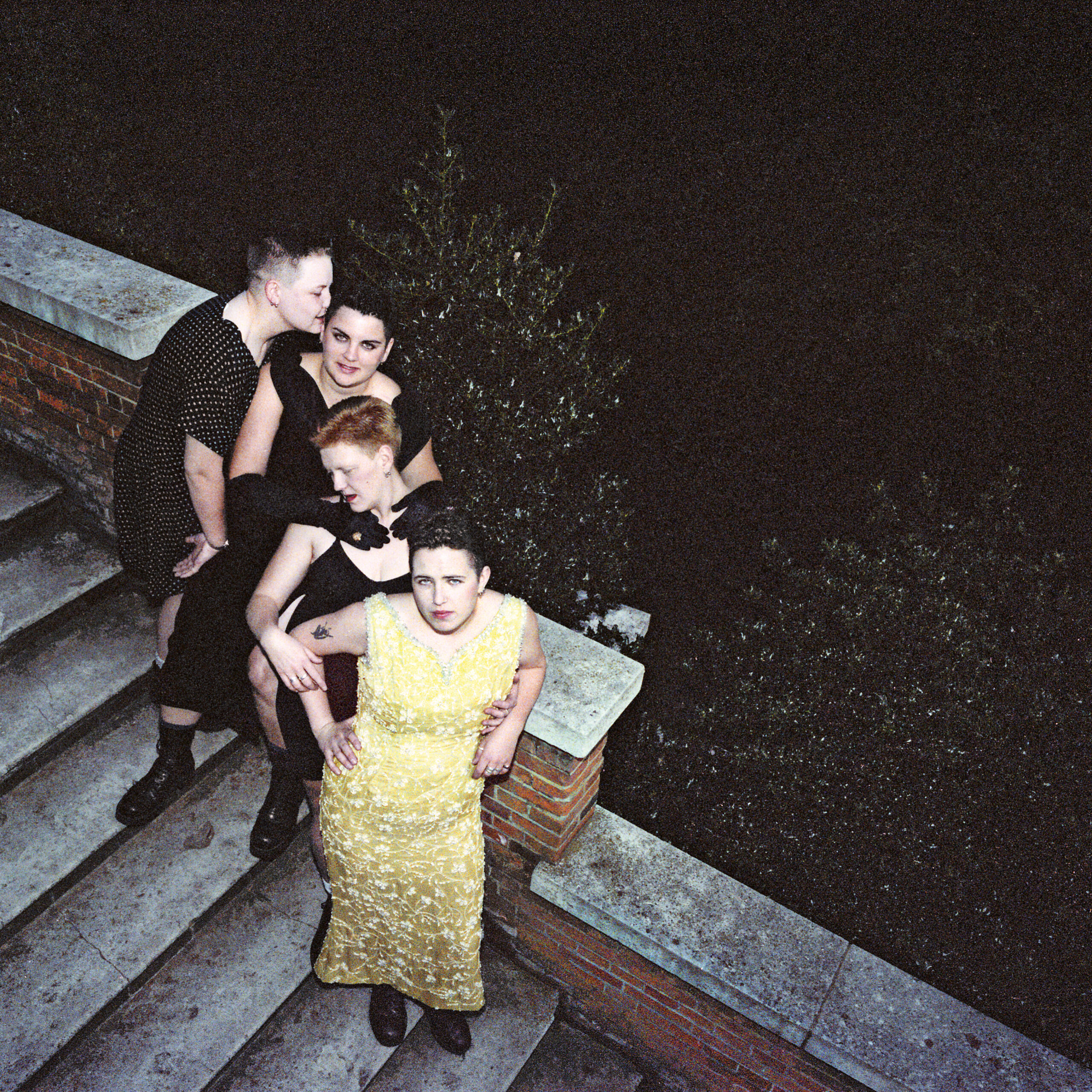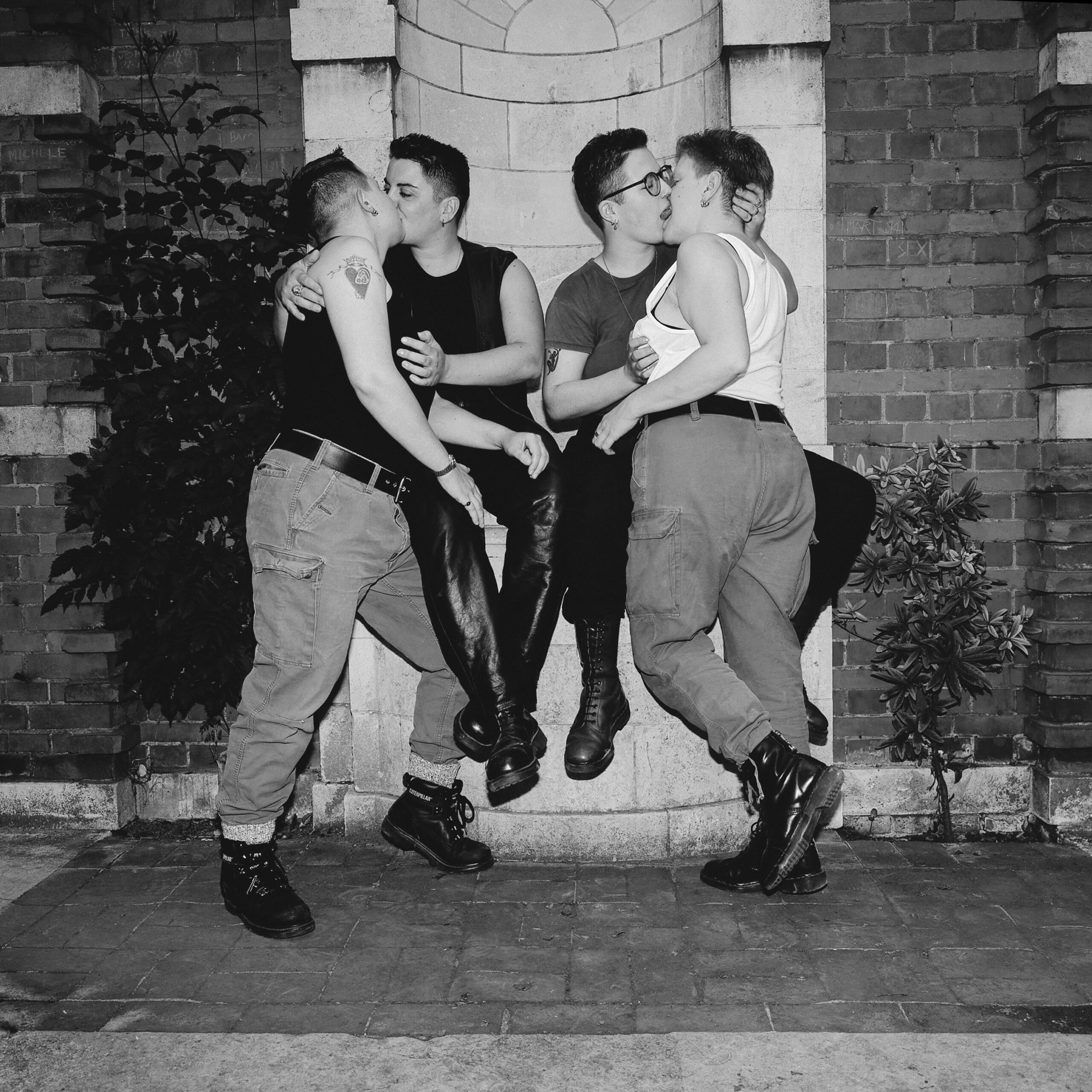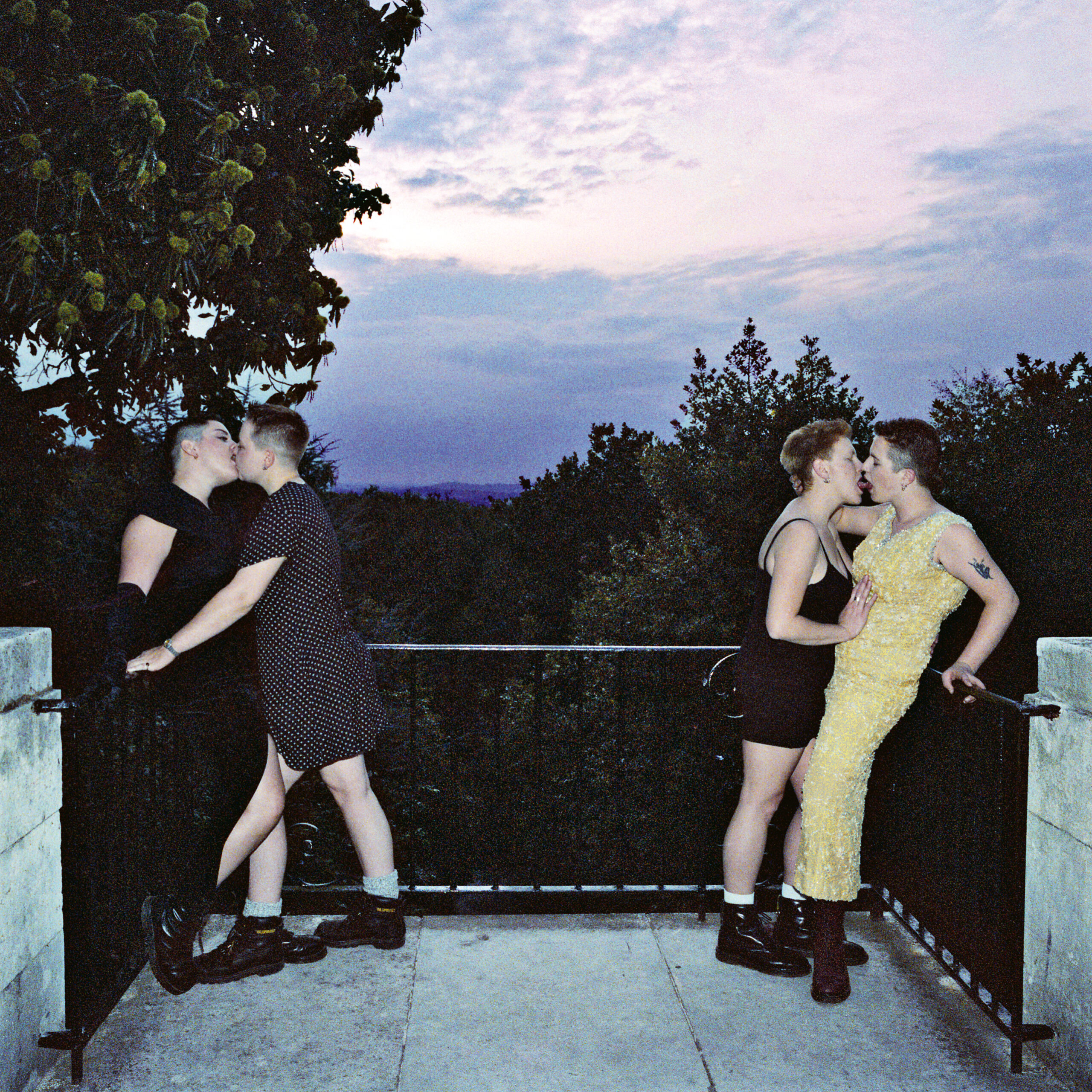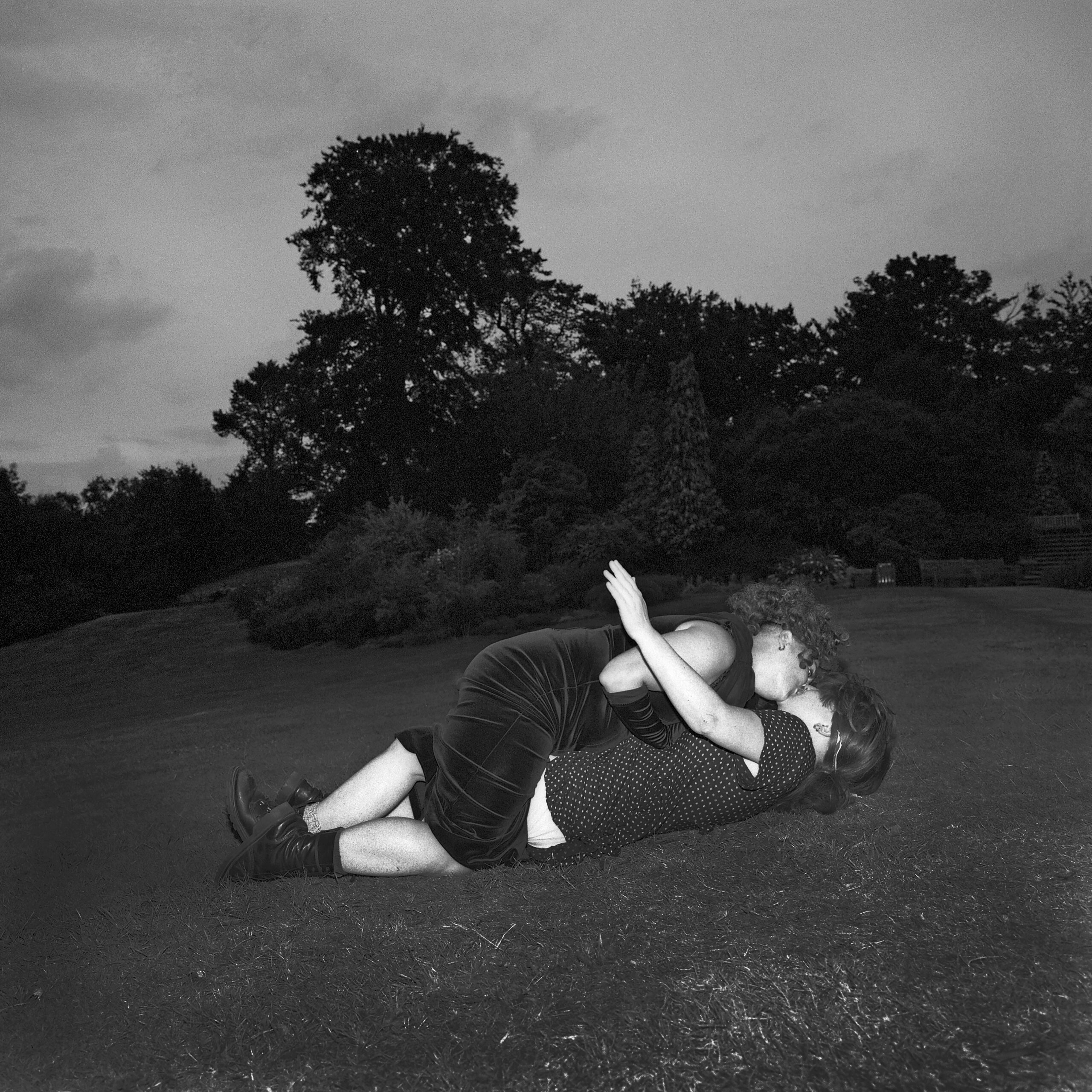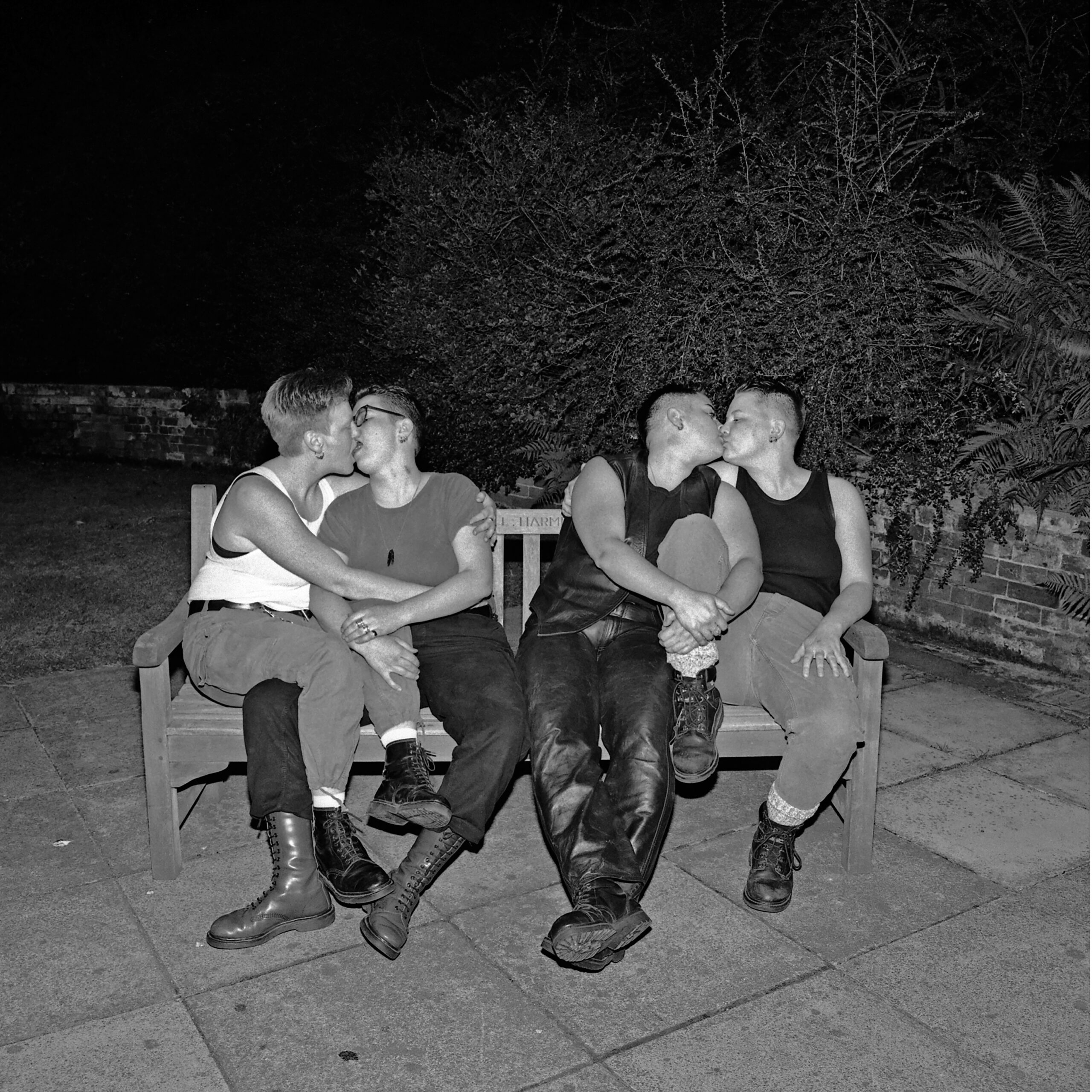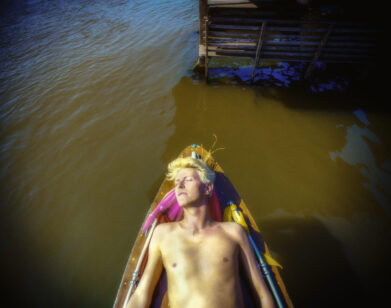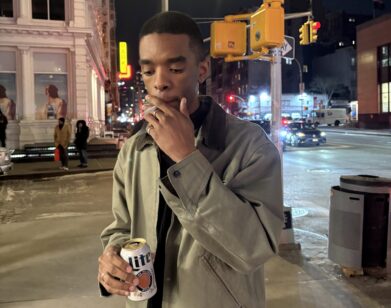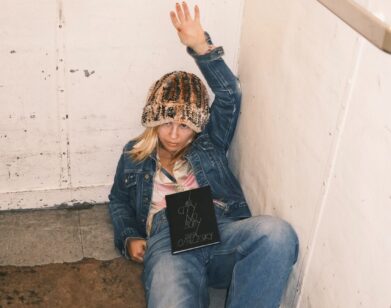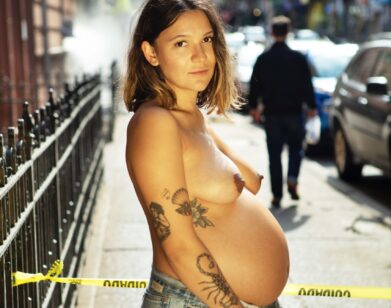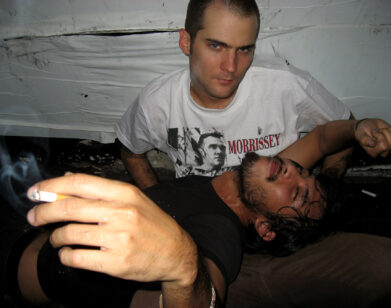XXX
Photographer Del LaGrace Volcano on Cruising, Community, and the Dyke-Fag Alliance
“I willingly confess to having an early interest in sex that eventually developed into a fetish for sex play in highly inappropriate locations,” Del LaGrace Volcano, the 67-year-old American artist, told me over Zoom last month. This remark can be easily confirmed by a glance at the cover of Del’s new book, which blares the title Queer Dyke Cruising under a photo of four dykes making out in a park. Over the past four decades, Volcano has made work, largely in film and photography, that documents and challenges the queer movement’s most radical ideas of gender and the very notion of how we’re meant to have sex. A self-described “gender abolitionist and part-time gender terrorist,” they’ve established themselves as a true legend. With this volume, published this week by Climax Books, the rare book dealership started by Isabella Burley, Volcano looks to bring their work to a new generation. From their living room in rural Sweden, Del LaGrace Volcano talked to me about the legacy of Claude Cahun, queer London in the 80s, and why gay guys and dykes should be having more sex with each other.
———
ADAM ELI: I’m such a fan of your work, so I’m just thrilled this worked out.
DEL LAGRACE VOLCANO: Thank you.
ELI: Okay. My first big question is, can gay guys say the word dyke?
VOLCANO: Yeah, of course. I’m wondering, do I ever say fag? Yes, sometimes with some gay friends. But it depends if they’re gay guys who love dykes or gay guys who hate dykes. There are some really right-wing misogynist gay guys out there that like the lipstick lesbians, but not so much full bulldaggers.
ELI: Totally. Misogyny and transphobia is alive and well in the gay community. I was wondering if you could give me some context for these photos about what was happening in London at the time. I know that the photos were shot in part in Hampstead Heath, which is famous for gay male cruising, as a way of claiming queer, dyke, and transmasc cruising.
VOLCANO: Yeah. First of all, if you look behind me in the pictures, there’s Arthur Tress and Ajamu, both good friends of mine.
ELI: I interviewed Ajamu.
VOLCANO: I love Ajamu. But I’ve always been attracted to the Marlon Brando outlaw. I rode motorcycles and that aesthetic is probably what attracted me to SM dykes and a certain kind of butchier androgyny at the time. If I didn’t know if somebody was male or female, I would probably follow them and eventually ask them for a date. So I was awake and alive in the ’70s, but I wasn’t cruising. Well, I don’t know. I was hitchhiking. But also, I’ve had all kinds of gay male friendships and relationships, sexual and romantic. I feel that that’s part of me. I can easily be in all gay male company and feel very much at home. The people who have supported me the most, especially early in my career, were gay men who would write about my work, like Jack Halberstam and Derek Jarman and a few others. I haven’t gotten that much support until recent years from the dykes or even lesbians. That’s a long-winded way of saying it feels like home to me because I came of queer age in San Francisco.
ELI: These photos were about reclaiming the space that was traditionally occupied by gay men for dykes so that they can cruise there with gay men. Is that correct?
VOLCANO: Yes, because I was like that. I am intersex and actually, in the last couple years, found out that I am the survivor of a vanishing twin and I have some of my XY twin’s DNA. So there’s a part of me that really feels like a gay man often. If I’m dressed like Del the dude, then people will see a queer gay man, especially if I have a shirt on. But even if I don’t, people generally assume I’m gay.
ELI: Maybe you could talk about Pansexual Public Porn, what that was and how that was an inevitable result of this series. Are those two connected?
VOLCANO: Yeah, absolutely. Same location. With Pansexual Public Porn, we used Super 8 cameras and took different groups of friends—trans, queer, dyke. No biological males were harmed in the production, but they did get their dicks out and have sex with us on camera. That was the condition. I hadn’t heard of anybody doing this at that time except in San Francisco, a trans photographer called Christopher Lee who made some films. But they were more dramatic and mine was more, “Let’s go out into the world and see what happens.” I mean, that’s how I make photographs, too. Just the pure kismet of it all, with this bald guy in a kilt.
ELI: You thought that you were going to be unsuccessful, but then it turns out that you were wildly successful having sex with all these gay men.
VOLCANO: Well, I wouldn’t go that far. I wouldn’t say wildly successful. I would say Hans was the bait more than me, and there were other twinkies that were bait. They didn’t expect to get what they got and they took it anyway. I also had failures that weren’t filmed. In Studland Bay, a guy comes out of the sea, looks good, and I start giving him a blow job. I’m jerking off, and he puts his hand in my pants and doesn’t get what he expects. He wasn’t shocked or horrified, and he just wandered away politely. That was the worst rejection I got. But the thing to understand, Adam, is that my role as a photographer or as an artist is to be a creator of spaces where people feel safe enough to give me what they’ve got.
ELI: And how was that done in both Queer Dyke Cruising and Pansexual Public Porn?
VOLCANO: It’s like some kind of weird gift of persuasion. The gift of the gab. Maybe it’s the Irish part of me. I can talk to people and persuade them to talk to me and in this case, persuade them to do that. I could fill up a whole book with just cruising pictures and that’s what I thought Climax wanted. They just wanted everything I had on this series, so that’s what they got. It’s very filmic, but I hope it does well. I’m still wanting to do a book of all the cruising pictures. This way of working is emblematic of how I work all the time.
ELI: It’s amazing. You mentioned earlier that you were born with an intersex variation. In Venus Boyz, I was so moved because you talk about non-consensual intersex surgery and someone off-camera says “they still do that” which is part of the fight that intersex people are facing now. I was wondering, what do you feel about the contemporary intersex movement, this #EndIntersexSurgery?
VOLCANO: I mean, I co-founded the only queer intersex organization here in Sweden. I’m glad all of the organizations exist, and I was involved for many years in the NGOs and intersex movement but I had to take a step back to become an artist again. I made a film called Journey Intersex, which was broadcast on Channel 4 a couple of times in the UK, about my cousin who was genetically mutilated and told she had cancer.
ELI: Thank you for sharing that. What artists, contemporary or not contemporary, are you looking at now? Who would you like to lift up?
VOLCANO: Besides myself, who actually needs to be lifted up? Because if I name my friends, they’re already in the stratosphere. I love Zanele Muholi, who I’ve known since the early 2000s before they went quite big. Ajamu, of course, but he also doesn’t need so much lifting up. I would say that I’m influenced by Claude Cahun. And Lee Miller. I have so many books on Lee Miller.
ELI: Tell me about your interest in Claude Cahun and how they inspired you.
VOLCANO: Well, Claude was politically both part of and apart from the Surrealist movement. And I can identify very strongly with the idea of being a part of and apart from different movements. He did self-portraiture, which I do a lot of. And he was just so fucking audacious. I mean, I think that people who know photography and queer stuff understand the importance of Claude Cahun. But I’m wondering, how much do people really know about him?
ELI: In the Jewish community, they’ve become quite a queer icon. Murray Hill is set to host a drag king reality competition series, and I want to know what you think about that.
VOLCANO: Murray is like total show business. I say go for it, Murray. Is it my actual cup of tea? No. There’s König in Berlin, and they’re a drag king organization. They put on these taboo performances with people in orthodox gear. I mean, they do really fucking edgy stuff in Berlin right now in the new drag community, and that’s what floats my boat. But I’ve worked with Murray. Murray’s in The Drag King Book.
ELI: What are you hoping people take away from the book?
VOLCANO: I hope that they’ll want to know more because I have so many subjects. I think it’s interesting that there’s this nostalgia for the ’80s and ’90s going on right now.
ELI: What do you think that’s about?
VOLCANO: I mean, it’s like a sugar cube in a bowl of cubes. I don’t want to diss it.
ELI: To prepare for this interview, I read a lot about you and rewatched Venus Boyz. But something that I took from your work that I’m excited about is the sexual connection between gay men and dykes, because I think people don’t talk about that enough.
VOLCANO: Yes, baby. I’ve been doing it my whole life. My dearest friend, Gino, we both came out as bisexual at 17 in California, and we were like cuddle buddies. We did end up having sex twice, but it was no big deal. I think that there is so much secret crossover. I saw myself for over 20 years as a dyke who occasionally had sex with men—gay men, straight men, whoever. But we did lose friends when Johnny Volcano and I got married. We consummated and that was it. We had a year-long flirtation and a night of passion. It can be so simple with gay men. It’s not like the dyke drama, and I appreciate that.
ELI: How do you think we can foster that sexual connection between gay men and dykes today? Because I do think it’s still stigmatized in the gay community, and that’s just obvious misogyny.
VOLCANO: I guess I choose my friends well. But I know how to ask for it. It’s just like if you’re Black, you’re going to avoid people that give off racist vibes. You can feel it, and I think it’s the same with gay men. If there’s any kind of reciprocity, you can feel it. I like to be cuddled. I’m a pretty small person. But gay women in general, I don’t get cuddles from. It’s gay men who we feel safe with. Dante Boo, my beautiful boy in Berlin, who’s from Montenegro, we can cuddle together. He’s a big old teddy bear, and who knows? It could develop someday into a sexual thing. Right now, it’s not. But the other thing about making photographic works with people in the street is you need to know how people want to be treated. You need to be able to read people and tell them what to do in a way that makes them want to do it. It’s the same thing with cruising.
ELI: I noticed that the photos in this series seem more artistically staged than some of your other cruising photos.
VOLCANO: It was not my decision. I mean, the idea of showing every single printable photo from the day was not my intention. That is what Climax asked for, and the only thing that really connects it is that I often work in triptych. I was a filmmaker first, so I do like a sense of movement. Now I have 50 years worth of negatives to digitize, and it’s a massive operation. But I’m still curious to see what people think of it. Because, as I said, they want it to be this kind of ries of a small book of a singular subject. And that’s the template.
ELI: I just rewatched Venus Boyz with my partner last night. It came out in 2002, and I was wondering, how do you feel about the film today?
VOLCANO: Geez, I haven’t watched it in so long. But I saw it plenty of times and I think it’s actually really good. I had more criticisms at the time. I thought it was quite long, and I thought, “Are people going to watch it to the end and see me?” I’m such a Leo, what can I say? I thought it was really comprehensive and tried to do a bit too much. But it did give me permission to let my own beard grow and to realize, if I had to live in a binary world, what would it be like if they assumed I was male? That turned out to be a more convenient and better fit for me. And besides, testosterone is a great drug.
ELI: In the introduction to the piece, Dominic Johnson wrote something so beautiful. Could I read a line of it to you?
VOLCANO: Yeah.
ELI: “In talking about cruising, it’s more comprehensively practiced by gay men, but is the cultural birthright of all queers. Its persistence or refusal to give it up despite surveillance, the law, and technological obsolescence informs its nature and meaning. Cruising lets us get off, but it also sends a message. We queers are killable by hatred, violence and disease, but our culture is not.”
VOLCANO: Oh, that is beautiful. I’ve read all of Dominic’s texts, but I hadn’t pulled that out.
ELI: Any thoughts about cruising being a cultural birthright of all queers?
VOLCANO: I think if you are defining queer the way Dominic is and the way I do, then I would say that we need to protect that birthright. It’s basically saying we have a right to exist on our own terms, a right to claim who we are. It’s not going to be for every gay man or every person. I don’t know if straight people do it, too. Do they? Do you know?
ELI: Probably a little bit.
VOLCANO: Do they call them swinger parties?
ELI: I think people pick each other up, but they might not use the word.
VOLCANO: They won’t do the look and walk away and follow kind of thing.
ELI: Could you tell me a little bit about Hampstead Heath and why you chose to put the Queer Dyke Cruising series there?
VOLCANO: Well, because it’s handy to where I lived in North London. I hung out there a little bit. But it was also a place that would be recognized by people I wanted to recognize it. There’s also Studland Bay, a beach that has a nude gay cruising ground, and Duke’s Mound in Brighton.
ELI: I know these photos were taken in a day. Is there anything particularly fun that you remember about it?
VOLCANO: Oh, yeah. I can’t quite remember, but at the end of the day they took off the leathers and put on dresses. Two of them put on short little dresses and two of them ball gowns.
ELI: Those photos are included in the book.
VOLCANO: They are. Before it was the drag king scene, we called it role playing in the BDSM movement that I was part of. All of the dykes in those pictures identified as more butch. Long before drag kinging, we were doing things like that. The motto was: permission to play. It was a safe place to be. You couldn’t do that in the regular club world or feminist world in London in the ’80s.
ELI: Was it safe in Hampstead Heath where you were taking the photos?
VOLCANO: Yeah, we were with gay men. Why wouldn’t we be safe? I mean, you’re talking to the wrong person when you’re talking about safety.
ELI: So that’s not a big concern for you and your work.
VOLCANO: It’s like my extreme sport. I was hitchhiking cross-country by the time I was 15. I was trafficked to Florida when I was 14. I had some time on the streets. I did some sex work. Luckily, I had a Mormon family in Oklahoma that took me in. Anyway, the point is that I missed that fear card. I’m more cautious now. I’m glad I lived through it all—including having unprotected gay sex with gay men who are HIV positive.
ELI: Is there anything that you’re excited about for the book coming out?
VOLCANO: I’m excited for all of it. I can’t wait to see it. I haven’t had a new book in a long time. I’m doing a lot of other things, too, but the book is a bit of a calling card. It opens some doors.


